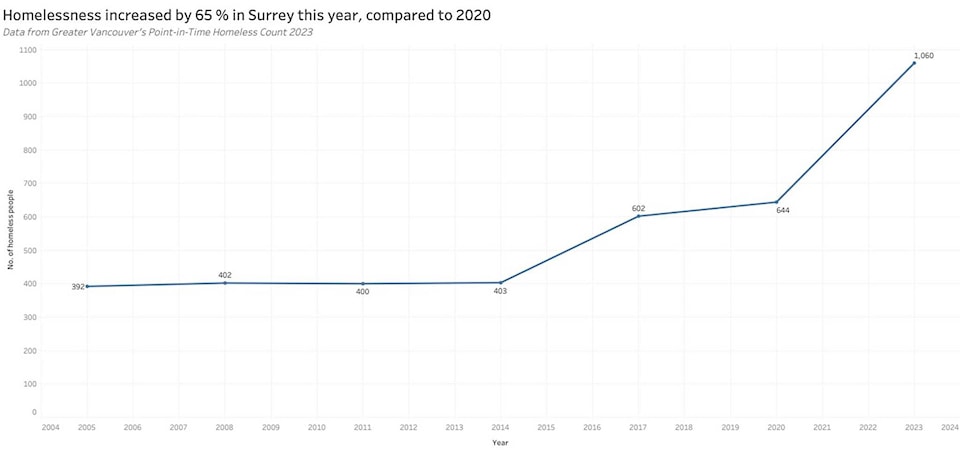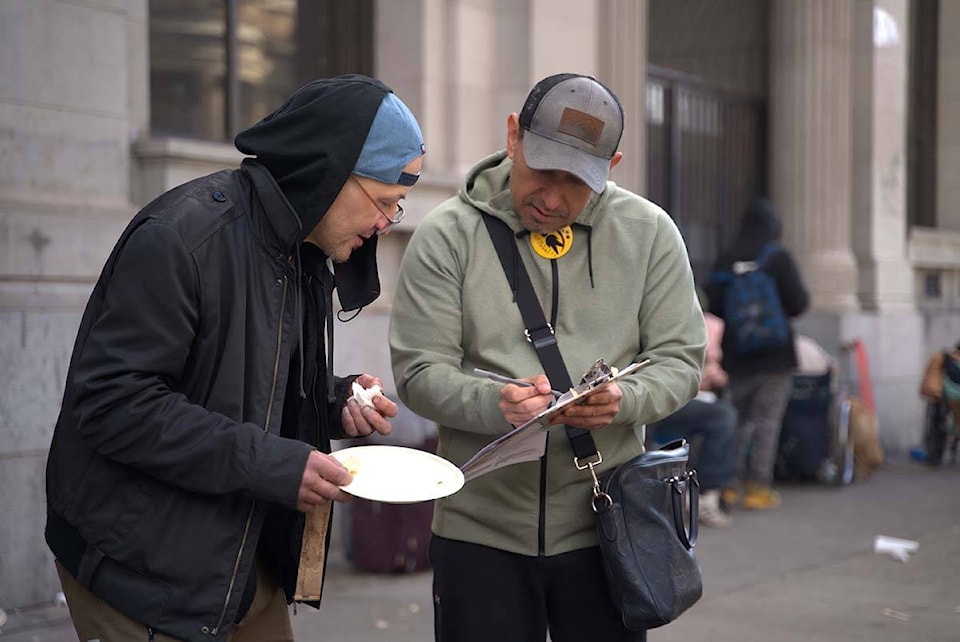The number of people experiencing homelessness in Surrey and White Rock have increased significantly since 2020, according to a count that returned to the area this year for the first time since the pandemic.
In March, volunteers explored several communities around B.C. in an effort to identify how many people are living unhoused in each city. The results for the Greater Vancouver Point-in-Time Homeless Count were released Thursday morning (Oct. 5). The survey was split into two days, with a shelter count on the night of March 7 and a daytime count the following day.
Surrey’s snapshot captures a devastating picture, with an estimated 1,060 people in the city who do not have a home. This marks a 65 per cent increase from 2020’s count, in which 644 individuals were identified.
The rise in Surrey is roughly twice the regional average of 32 per cent across Greater Vancouver.
“I am troubled but not surprised to see an increase in homelessness in Surrey,” mayor Brenda Locke said in a news release.

The city’s jump in homeless population over the last three years is not consistent with past trends. From 2005 to 2008, the number of unhoused residents increased by 10 people — 392 to 402. In 2011, that number decreased by two, to 400. Between 2014-17, the numbers jumped from 403 to 602 – an increase of 49 per cent.
Also among the 11 communities surveyed was White Rock, a community that is more recently noticing a rise in the number of visibly homeless individuals, and the numbers from the count do show a slight increase.
READ MORE: ‘There are humans on the street’: Supportive housing sites sought in South Surrey
In 2023, the count for the city sits at 17 people, an increase of one person from 2020.
However, organizers of the homeless count are urging the public to look at the numbers with a critical eye.
“The limitations of this methodology have to do with the time-frame the count is conducted, and the nature of the process being a voluntary survey,” reads a portion of the report.
“It is important to understand that this methodology will create a result that is an absolute minimum number of people who are experiencing homelessness on the specific day of the count, and this methodology means that those who are not currently accessing services or are easily found will most likely be excluded.”
As a region, 4,821 people were identified as homeless in Greater Vancouver, up 32 per cent from the last count three years ago.
READ MORE: Homelessness up 32% in Metro Vancouver compared to 2020
Of the 17 people noted in White Rock, 11 were classified as unsheltered and six with no fixed address, meaning the six people in this count were staying in police holding cells or health facilities. Those staying in the healthcare settings were doing so temporarily, with the expectation they would be discharged within 30 days of the count date, but had no home to return to.
The city’s results were also influenced by the area shelters’ inconsistent service last winter.
“In White Rock, a shelter program was closed in the weeks before the Count and opened in South Surrey. These 12 individuals were counted in the Surrey-Sub Region, but most regularly spent the days in White Rock,” the report notes.
There were two people found to be unsheltered in White Rock on the night of the count in 2020, including individuals who were sleeping outside, in tents or makeshift shelters, in vehicles and more. That number jumped to 11 in this year’s count.
In Surrey on the days of the count, 301 people were unsheltered, 109 were accessing extreme weather shelters, while 589 were using other shelters and a total of 61 people had no fixed address.
Individuals surveyed during the count are also classified by specific identities, including Indigenous and racialized people, those who identify as 2SLGBTQ+, youth, seniors and more. Although Indigenous people make up two per cent of Metro Vancouver’s population, according to Census data, this group represents 33 per cent of the unhoused population for the region.
Surrey is the municipality with the largest urban Indigenous population in the province, with 16,300 people calling the city their home, according to a 2022 report by Skookum Surrey.
In the Whalley neighbourhood, a new supportive housing site of 60 units is expected to open in November. Another location for vulnerable populations is under construction. It will include 30 units for youth and young adults in Fraser Heights, but there are currently no sites announced for the south end of the city.
RELATED: Surrey working to provide a ‘safe sleep’ for homeless people
White Rock’s daytime warming shelter may not return to the city this winter, as a location or locations have not been found. There are also no supportive housing sites in White Rock for people experiencing homelessness.
